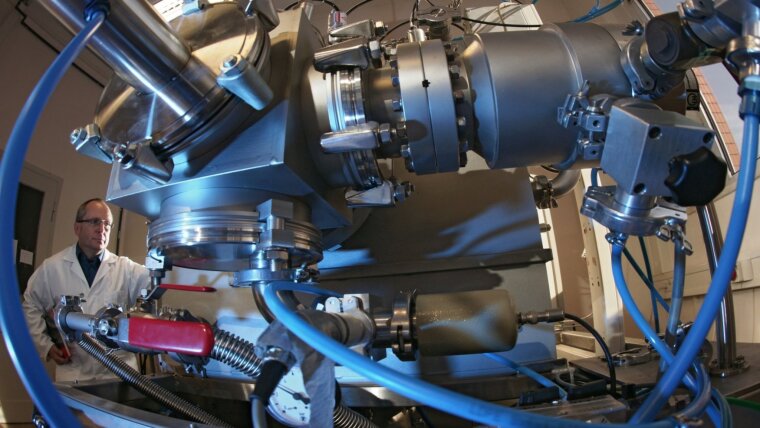
Prof. Torsten Fritz
Image: Anne Günther (University of Jena)Prof. Dr. Torsten FRITZ
Email: torsten.fritz@uni-jena.de
Phone: +49 3641 9-47400
Torsten Fritz is professor and chair of Applied Physics / Solid State Physics at the Institute of Solid State Physics (IFK) at the FSU Jena. His research group is engaged in the research on nanostructures, surfaces, and thin films of both organic and inorganic semiconductor materials, with emphasis on 2D materials. The group has a network of theoretical and experimental collaborators in Germany, Austria, USA, and Japan. Our main research interest lies in the discovery of structure-property-relations of structurally well-defined ultrathin epitaxial layers, organic quantum wells, K-doped organic super conductors, and modern 2D materials (epitaxial graphene, transition metal dichalcogenides). The main target of our research is the development of basic principles for the use of optoelectronic nano materials in prospective devices.
Our in situ optical spectroscopy, namely differential reflectance spectroscopy (DRS), is used to study ultrathin films (effective film thickness down to 0.03 nm) organic (sub-)monolayers and heterostructures in terms of absorption spectroscopy to analyze the optical interaction between either the molecules itself, organic adsorbates and inorganic substrates, or molecules and dopants. For the analyses of the chemical composition and bonding at surfaces and in thin films we use surface analysis methods like photoelectron spectroscopy (XPS, ARUPS) and Auger electron spectroscopy (AES). The crystalline structure can be determined by electron diffraction (LEED, RHEED, XPD). Scanning tunneling microscopy (STM) and atomic force microscopy (AFM) at ultra-low temperatures (T = 1.1 K) are used for high-resolution imaging of nanostructures and surfaces.
Research Areas
The surface science group of Prof. Fritz is involved in the research of organic molecules which in the form of thin films possess semiconducting properties. We specialize in the preparation and characterization of highly ordered (epitaxial) layers on singlecrystalline substrates in ultra-high vacuum, placing emphasis on the structure-property-relations. Further research topics include 2D-materials (epitaxial graphene, hexagonal boron nitride (h-BN), transition metal dichalcogenides) and organic
superconductors. The diversity of complementary experimental methods (optical spectroscopy, photoelectron spectroscopy, electron diffraction, scanning probe microscopy at 1.2 K, and many more) is a key aspect of this group.
Teaching Fields
- Solid-state physics
- Advanced solid-state physics and materials science
- Organic and inorganic semiconductors
- Surface science
Research Methods
- Low-temperature scanning probe methods at 1.2 K (STM, AFM, STS)
- In-situ optical spectroscopy (Differential Reflectance Spectroscopy [DRS], PL)
- All variants of photoelectron spectroscopy (ARPES, XPS, PMM, AES, XPD)
- Quantitative distortion corrected electron diffraction (LEED, RHEED)
- Joule-Thomson STM/AFM (specs: T control <20 K [MCPLEED, DRS] or 1.2 K [STM, AFM], H-field ~3 T, 4-probemeasurements, organic molecule crucibles, Ar sputter gun and e-beam heating, doping, QMS)
- Surface analysis system (specs: T control down to 20 K [XPS, UPS, ARUPS], monochromatic UV source, crucibles for organic molecules, Ar sputter gun and e-beam heating, doping with alkali metals and alkaline earth metals, MCP-LEED, AES, DRS, QMS)
Recent Research Results
- In-depth characterization of the potassium doping of PTCDA monolayers, including the direct observation of the K adsorption sites [1-3]
- First direct observation of static distortion waves (SDWs) in flexible 2D crystals of organic molecules [4]
- Study of dielectric background effect on optical transition energies of isolated molecular monomers and weakly interacting two-dimensional aggregates [5]
- Development of a full and most comprehensive classification scheme of the epitaxial types in reciprocal and real space, including both, rigid and flexible lattices [6]
- Development of a new consistent model for the interpretation of different spectroscopic results (including ARPES, IPES, 2PPE, and optical spectroscopy) which takes into account the perturbations of the different measurement processes on a molecular system [7]
[1] C. Zwick et al., ACS Nano 10, 2365 (2016).
[2] A. Baby et al., ACS Nano 11, 10495 (2017).
[3] C. Zwick et al., Phys. Rev. Materials 3, 085604 (2019).
[4] M. Meissner et al., ACS Nano 10, 6474 (2016).
[5] R. Forker et al., Phys. Rev. B 93, 165426 (2016).
[6] R. Forker et al., Soft Matter 13, 1748 (2017).
[7] T. Kirchhuebel et al., Phys. Chem. Chem. Phys. 21, 12730 (2019).
